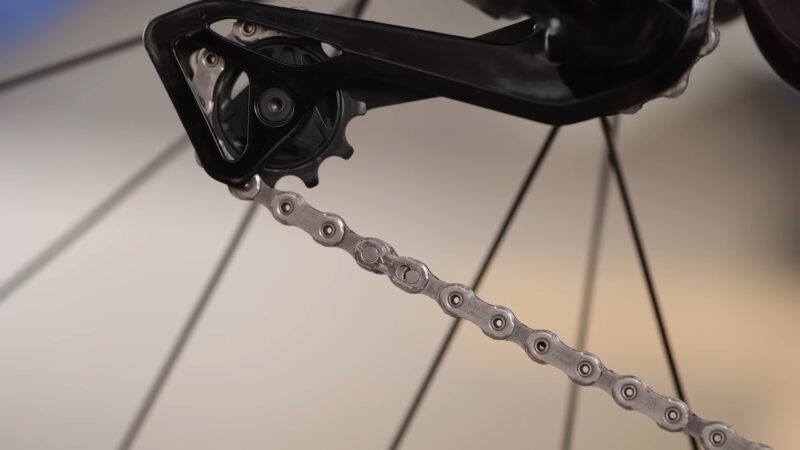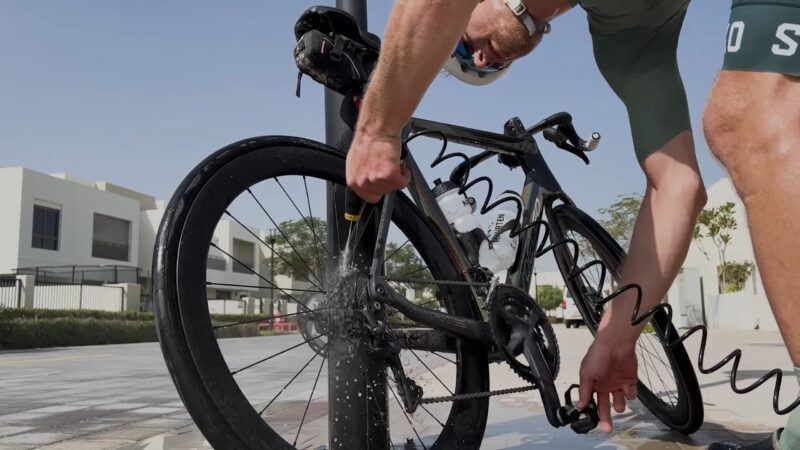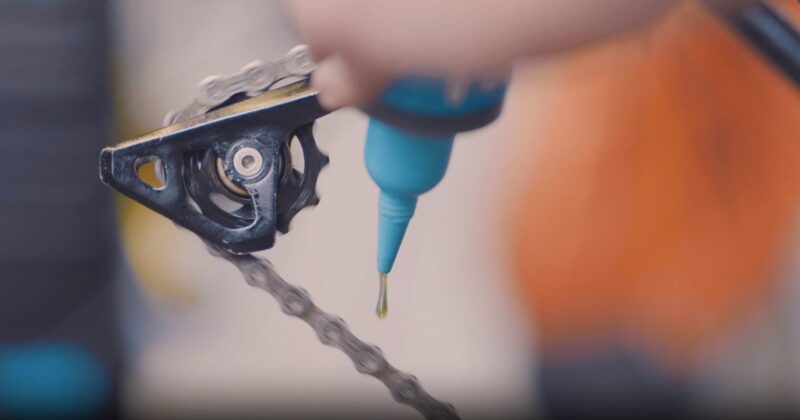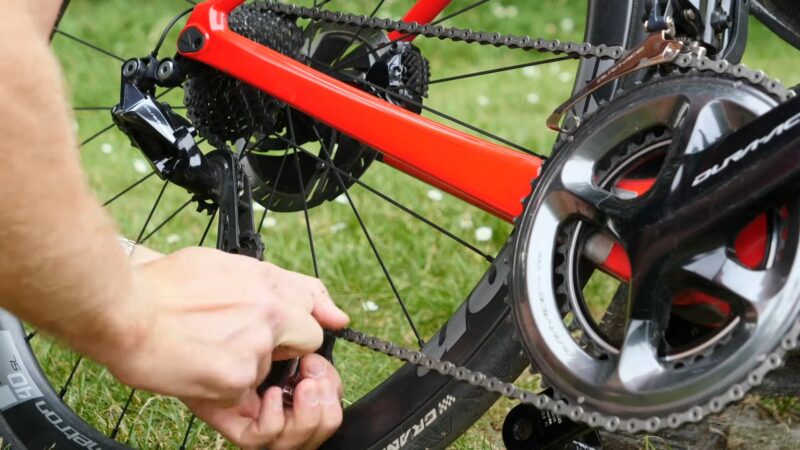The humble bike chain might seem like just another component of your bicycle, but trust me, it’s the hero of your cycling adventures. Imagine trying to pedal without it; you’d be going nowhere fast. Literally!
The bike chain is the crucial link (pun intended) that transfers the power from your legs to the wheels, propelling you forward. Without it, you’d just be sitting on a stationary frame, going nowhere.
Fun Fact: Did you know that a bike chain can have up to 116 links or even more? That’s a lot of tiny pieces working together to keep you moving!
It’s Significance

The bike chain might seem simple, but it plays a pivotal role in the overall functionality of a bicycle. Every time you pedal, it transfers that energy to the wheels, allowing you to move.
A well-maintained one ensures that this energy transfer is efficient, giving you a smoother ride. On the flip side, a neglected one can make your ride feel sluggish and can even damage other components of your bike.
Pro Tip: Regularly checking your chain for wear and tear can save you money in the long run by preventing damage to more expensive bike parts!
Factors Affecting Cost

When it comes to buying new, several factors can influence the price:
- Material and Build Quality: Just like jewelry, the material can significantly affect its cost. Higher quality metals tend to last longer and offer better performance but come at a higher price.
- Brand and Reputation: Established brands often charge a premium for their products because they’re trusted by professionals and enthusiasts alike.
- Chain Type: Whether you’re riding a single-speed cruiser or a multi-speed mountain bike, the type o you need can vary, and so can the price.
- Coating and Special Features: Some come with special coatings to resist rust or other features that can add to the cost.
Average Cost
They come in a variety of price ranges, largely depending on the factors mentioned above. On average, you can expect to pay anywhere from $10 to $90.
For example, a one-speed bike chain might set you back around $15, while specialized ones like the Zonkie speed bike chain or the Bibike Speed bike chain can range from $13 to $48. And remember, if you’re into road cycling, mountain biking, or BMX, the type you need might differ, affecting the price.
Pro Tip: While it’s tempting to go for the cheapest option, investing in a good quality chain can save you money in the long run by reducing the frequency of replacements and potential damage to other bike components.
Signs of a Wear

We’ve all been there. You’re pedaling along, and suddenly something feels off. Maybe your bike isn’t shifting as smoothly, or perhaps there’s a strange sound resounding. These could be signs that your bike chain is on its last legs. Here’s how to recognize when it’s time for a change:
- It Physically Snaps: While rare, they can break, especially if you’re pedaling hard and shifting simultaneously. This force can be too much, causing it to snap. If this happens, it’s a clear sign that your chain was nearing the end of its life.
- The It is Worn Out: As you clock in more miles on your bike, it naturally wears out. Over time, the pins that hold the links together wear down, causing the chain to stretch. A stretched chain can wear out your bike’s cassette and chainrings, affecting the efficiency of shifts. If you notice any cracks or deformities, it’s time for a replacement.
Fun Fact: A chain doesn’t actually “stretch” in the traditional sense. Instead, the wear and tear on the pins cause the chain’s length to increase.
Maintenance to Extend Life

Want to get the most out of your bike chain? Here are some tips to prolong its life:
- Proper Cleaning and Lubrication: Keeping your chain clean and well-lubricated is the best way to ensure it lasts longer. If you often ride in sandy or dirty environments, make it a habit to wipe down and lubricate regularly. Use wet lube if you’re in a damp environment to prevent rust.
- Correct Tension and Alignment: Ensuring your chain has the right tension and is properly aligned can prevent unnecessary wear and tear.
Pro Tip: Invest in a chain checker tool. It’s a quick and accurate way to check if your chain has stretched too much. If one end hooks into the chain and the other fits into a link, it’s time for a replacement.
When to Replace
Knowing when to replace your chain can save you money and ensure a smooth ride. Here are some criteria to consider:
- Wear Indicators: Tools like the Park Tool Chain Checker can quickly tell you if yours is stretched and needs replacing.
- Stretch: As mentioned, they don’t truly stretch. Instead, the pins wear down, causing an increase in length. Riding on a “stretched” chain can damage other parts of your bike.
- Frequent Gear Slipping: If your gears are slipping often, it might be a sign that your chain is worn out and needs replacement.
Pro Tip: After the first 500 miles on a new chain, check it for wear. After that, inspect it every 250 miles. Regular checks can prevent damage to other, more expensive parts of your bike.
DIY vs. Professional Replacement
Ah, the age-old debate: to DIY or not to DIY? When it comes to bike chain replacement, there are pros and cons to both approaches.
Going the DIY Route

Pros
- Cost Savings: Once you’ve invested in the necessary tools, replacing it yourself can save you the labor costs each time you need a new chain.
- Learning Experience: There’s a certain satisfaction in understanding the mechanics of your bike and being self-reliant.
Cons
- Initial Tool Cost: The first time you replace your chain, you’ll need to invest in tools like pliers or a chain tool, which can range from $15 to $40. However, these tools are a one-time purchase and will last a lifetime.
- Potential Mistakes: If you’re new to bike maintenance, there’s a learning curve. Mistakes can happen, but they’re all part of the learning process.
Seeking Professional Help

Pros
- Expertise: Bike mechanics have the experience and knowledge to efficiently replace a chain and spot other potential issues.
- Convenience: Drop off your bike, grab a coffee, and come back to a freshly replaced chain.
Cons
- Cost: Professional services come with labor costs. Depending on where you live, this can range from $10 to $20, not including the chain itself.
Fun Fact: Did you know that some professional cyclists have their chains replaced every few races to ensure peak performance?
Cost Comparison
When it comes to bike maintenance, costs can vary widely based on the task at hand. Replacing is relatively affordable, especially when compared to other maintenance tasks. For instance:
- Tire Replacement: Depending on the type and brand, a single bike tire can range from $20 to $80 or more.
- Brake Pads: Replacing brake pads can cost anywhere from $7 to $30 per set, not including labor.
- Bike Chain: Range from $10 to $90.
Regular maintenance, like cleaning and lubricating your chain, can prevent more costly repairs down the road. It’s an investment in the longevity and performance of your bike.
FAQ
What’s the average lifespan of a bike chain with regular maintenance?
While the lifespan can vary based on factors like usage, maintenance, and riding conditions, with regular care, one can last anywhere from 2,000 to 5,000 miles. However, it’s essential to check it periodically for signs of wear and replace it when necessary to ensure optimal performance.
Are there any specific brands recommended for bike chains?
While the article mentions SRAM and Shimano as reliable brands, many cyclists also swear by KMC and Connex. It’s essential to choose a chain compatible with your bike’s gear setup and to consider factors like durability, weight, and shifting performance.
How can I ensure my bike chain doesn’t rust in wet conditions?
To prevent rust, especially if you frequently ride in wet or damp environments, it’s advisable to use a wet lube. This type of lubricant is designed to repel water and protect your chain from moisture-induced corrosion.
Is there a difference between chains for regular bikes and those for electric bikes (e-bikes)?
Yes, e-bikes often require specially designed chains due to the additional torque and power they produce. These are built to withstand the increased stress and usually have a longer lifespan. It’s crucial to check the manufacturer’s recommendations when choosing a chain for an e-bike.
Conclusion
Your bike chain is more than just a series of links; it’s the lifeline of your bicycle, ensuring every pedal stroke translates into movement. Regular maintenance, timely replacement, and understanding the associated costs are crucial for every cyclist, whether you’re a weekend warrior or a daily commuter.
By giving your chain the attention it deserves, you’re not only ensuring a smoother ride but also safeguarding your overall cycling experience. So, the next time you’re out and about, listen to that gentle hum, and know that with the right care, many more rides await!
Safe cycling!
